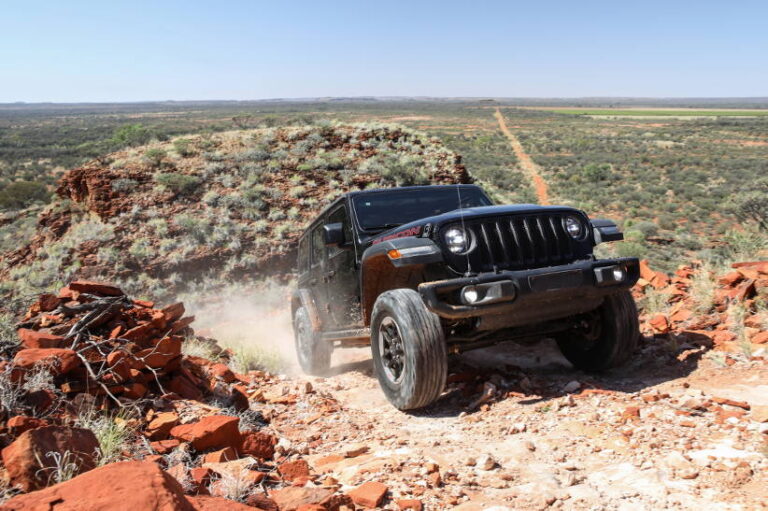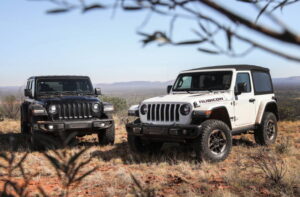Ahead of its arrival in late 2018, the all-new Jeep Wrangler has completed its first Australian engineering assessment in some of the country’s most unforgiving driving conditions.
In an effort to better understand the way Australians use their vehicles, particularly in some of the country’s toughest terrains, Jeep Wrangler engineering program manager, John Adams, and off-road development lead engineer, Bernie Trautmann – both from Jeep’s US headquarters – approved a testing program to take place in mid-January in the Australian Outback.
The vehicles selected for the program were two JL Wrangler engineering prototypes; a 2-door Rubicon variant powered by a new turbo-charged two-litre, four-cylinder engine that generates 201kW and 400Nm of torque, and a 4-door Rubicon version packing the tried and tested 3.6-litre Pentastar V6 that delivers 213kW and 353Nm.
These vehicles are the first test units of six prototype stages that are built before the final ‘job-one’ production version.
The key objective of the technical evaluation program was to collect a range of specific vehicle performance data prior to the commencement of right-hand drive production of the new Wrangler, which begins later this year.
As such, Johns and Trautmann based themselves in Alice Springs to cycle through an intensive test program that primarily focussed on suspension calibration and extreme hot weather engine performance of the all-new JL Wrangler. This follows extensive testing in major international markets such as China, India, Brazil and Russia.
“Australia presents some incredibly unique driving environments so it was in our best interest to visit and understand if there were some new learnings that we could apply to the development of the new Wrangler – specifically for this market,” Wrangler program manager John Adams said.
“Explicitly, we were looking at the effect of Australia’s corrugated roads on long-range and high-speed drives which are common for much of the country’s population outside of the cities – and how our suspension tuning processes these inputs, combined with the extreme heat effects on our engine, transmission and cooling system management temperatures.
“We understand there’s an expectation from the Australian market that their vehicles are appropriately tuned to the country’s unique driving conditions and it’s for that reason we initiated the program to investigate if there’s anything we could be doing differently when it comes to delivering the Wrangler for Australia,” Adams added.
Prior to its production in the United States, the all-new Wrangler underwent more than 6.2 million kilometres of testing. Extreme-weather testing occurred in various environments, including the blistering Arizona heat (58 degrees Celsius) and acute cold of Alaska (-40 degrees Celsius) for months at a time.
In addition to the laboratory and standardised testing, the Wrangler was subjected to global test miles across China, Brazil, India, Russia, Italy and the Middle East – as well traversing the famed Rubicon Trail in a completely unmodified guise – a mandatory capability test for the Wrangler to wear the Rubicon moniker.
Australia now joins these locations as a key location for Wrangler testing.
With daytime temperatures in excess of 45°C, Alice Springs provided Jeep’s US engineers with a challenging proving ground in which to put the Wrangler through its paces, serving up a variety of tough and technical terrain – including high-speed corrugations, washouts, soft sand hills and low-range rock climbs. Both Wranglers performed flawlessly in the extreme conditions.
Jeep’s off road development lead engineer, Bernie Trautmann, was pleased with the progress made during the Australian evaluation.
“From the outset, our mission here was to collect as much data as possible, from as many different driving conditions as possible and the Australian outback certainly delivered this opportunity.
“We were really happy with the way the vehicles performed and were able to gain some valuable accelerometer and engine data to take back to our US headquarters for analysis, before determining our next steps,” Trautmann said.
FCA Australia’s CEO and newly-appointed Head of Jeep brand for the Asia Pacific region, Steve Zanlunghi, said that this development program further highlighted the importance of the Australian market.
“Thanks to feedback from our customers and dealer network, we have been in discussion with our US headquarters for some time now regarding local testing of our vehicles.
“Last month’s program is a clear illustration of our commitment to providing our customers with vehicles that are not only fit for purpose, but exceed their expectations when it comes to quality, comfort and an exceptional driving experience no matter how demanding the conditions.”







